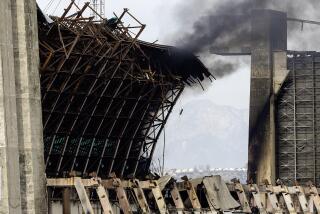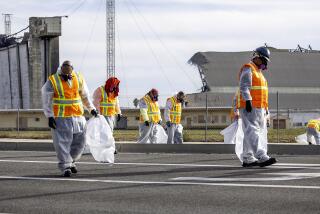It Pays to Hang Around : Engineers Finally Pay Respects to WWII-Era Marine Base Structures
- Share via
TUSTIN — To see a group of engineers gush over the blimp hangars at the Tustin Marine Corps Helicopter Air Station, you would think the giant structures were the eighth wonder of the world.
Maybe that is exaggerating the hangars’ importance, said Fred J. Meier, a retired civil engineer from Santa Ana, but not by much.
Thanks to a nearly three-year effort by Meier, the twin hangars Thursday received the same national recognition that has been extended to other engineering landmarks in the United States, including the Statue of Liberty and the Golden Gate and Brooklyn bridges.
In a ceremony at the Marine base, the American Society of Civil Engineers dedicated a plaque that recognizes the two hangars as the largest wooden frame structures in the world. Although the buildings already are listed on the National Register of Historic Places, the event still had all the pomp of a military ceremony, complete with color guard.
“What makes these hangars unique is they are the largest wooden structures of their kind in the world,” Meier said. “The frame is made entirely of wood, and we believe they support the largest covered space of any building in the world.”
Built in 1942 at a cost of $2.5 million each, the hangars housed 12 blimps used for submarine patrol. Each structure stands 18 stories high, 1,088 feet long, 297 feet wide and covers almost 300,000 square feet. It is possible to play a basketball game, football game and soccer match in one building simultaneously.
The huge wooden doors, which have six leaves that weigh between 26 and 39 tons each, fold open on steel rails like an accordion, powered by electric motors at each end. Giant concrete pylons anchor each corner of the hangars.
Construction was supervised by the Navy Department’s Bureau of Yards and Docks. Wood was used for the framing because steel was needed to build ships, tanks and weapons for World War II.
Hank Klehn, executive vice president of Dames & Moore, a Los Angeles-based engineering firm that helped construct the hangars, said the soft, swampy ground presented a challenge that few engineers had faced.
“Back then, our firm was one of a handful in the country that specialized in foundation engineering,” Klehn said. “Our engineers bored 150 feet down to get soil samples that were tested for strength and compressibility. From those tests, the engineers decided the best foundation for the buildings were pilings that were pounded 100 feet into the ground.”
The fact that the pilings and buildings have survived several earthquakes is testament to the ingenuity of the engineers, who were working in a new science, Klehn said.
After the war, blimps were phased out, and over the years the hangers saw a variety of non-military uses. In 1949, Howard Hughes rented space in one hangar for a blimp that his company used to advertise the movie “The Outlaw,” which was produced by Hughes and starred Jane Russell. Local canning and trucking companies also rented storage space in the hangars in 1950.
In 1951, when the Korean War began, Tustin was recommissioned as the first Marine helicopter base. Today, each hangar can house almost 100 helicopters.
The Marine Corps is scheduled to close the base by 1997 and turn the land over to the city of Tustin. It is not know what will happen to the two hangars.
“This is not an attempt to preserve the buildings,” Meier said. “I would like to see them preserved, but that’s not up to me or to our group. We simply want them to be recognized for the engineering marvel that they are.”
More to Read
Sign up for The Wild
We’ll help you find the best places to hike, bike and run, as well as the perfect silent spots for meditation and yoga.
You may occasionally receive promotional content from the Los Angeles Times.






